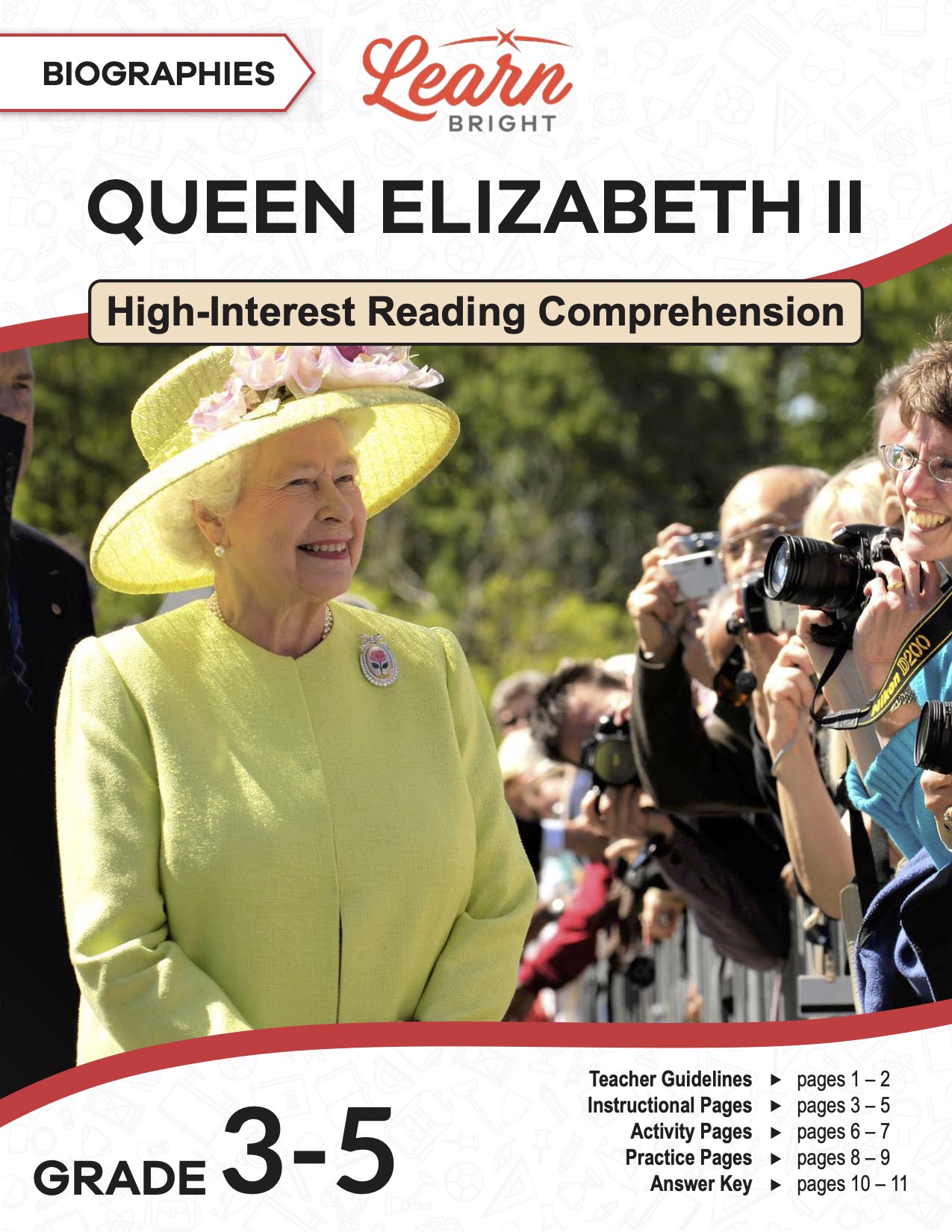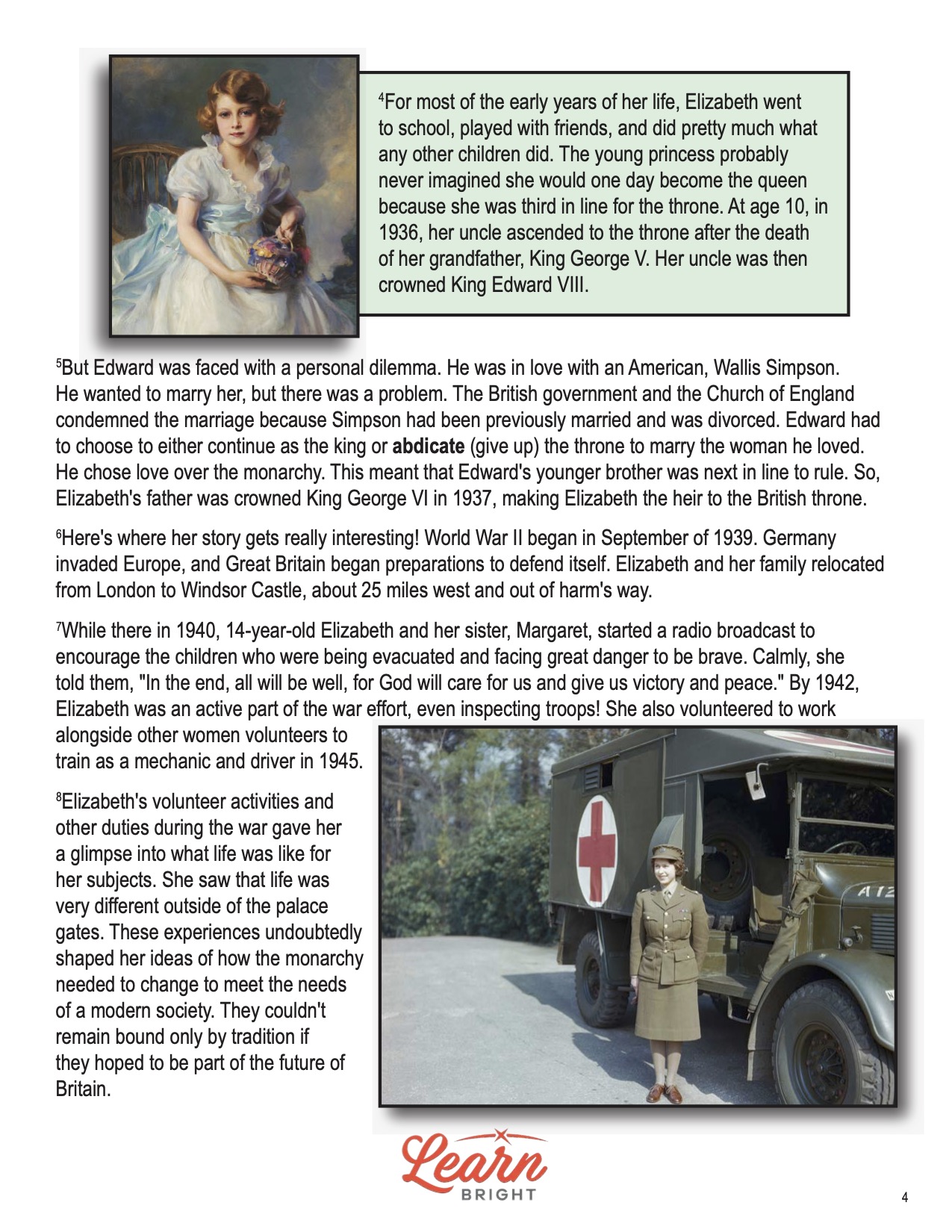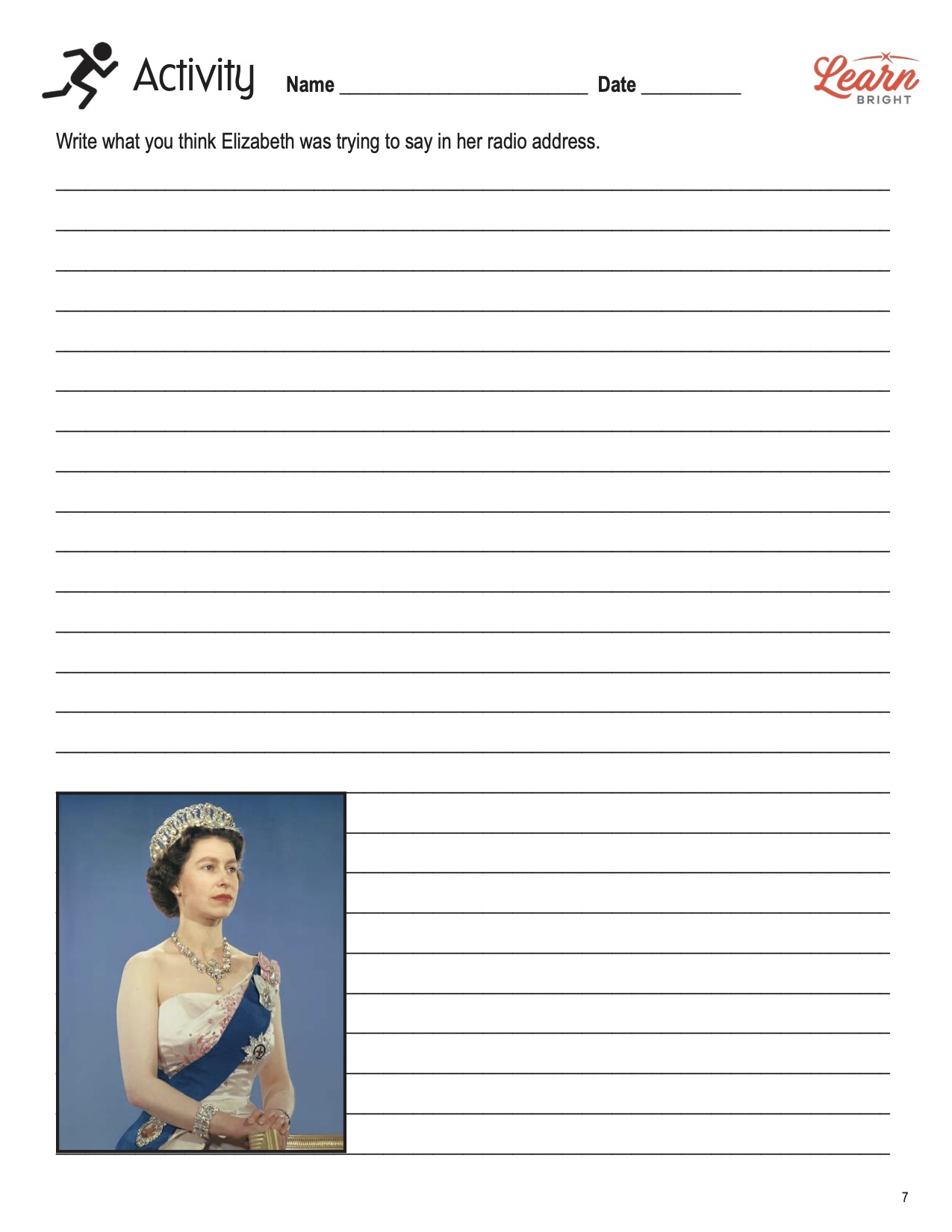Description
What our Biographies: Queen Elizabeth II lesson plan includes
Lesson Objectives and Overview: Biographies: Queen Elizabeth II is a high-interest reading comprehension lesson plan. As such, students will practice various close reading and comprehension skills. In addition, they will learn about the life and legacy of one of England’s most popular monarchs. This lesson is for students in 3rd grade, 4th grade, and 5th grade.
Classroom Procedure
Every lesson plan provides you with a classroom procedure page that outlines a step-by-step guide to follow. You do not have to follow the guide exactly. The guide helps you organize the lesson and details when to hand out worksheets. It also lists information in the yellow box that you might find useful. You will find the lesson objectives, state standards, and number of class sessions the lesson should take to complete in this area. In addition, it describes the supplies you will need as well as what and how you need to prepare beforehand.
Teacher Notes
The paragraph on this page provides a little more information or guidance on what to expect from the lesson. It explains that you can teach this lesson in a whole-class setting or as an independent, small-group activity. You can use the blank lines to record any thoughts or ideas you have as you prepare.
BIOGRAPHIES: QUEEN ELIZABETH II LESSON PLAN CONTENT PAGES
The Queen of England
The Biographies: Queen Elizabeth II lesson plan contains three content pages. It’s hard to imagine the United States having a king or queen. That’s mainly because colonial Americans revolted against the King of England to become an independent nation back in 1775. Today, the United Kingdom is the United States’ most important ally and global partner. Royalty is still an essential part of its government. This includes the late Queen of England, or her more formal title, Queen of the United Kingdom and other Commonwealth Realms.
The story of Queen Elizabeth II is not a fairy tale, although her life reads like one. She was the longest-reigning monarch in British history. Her reign lasted an astounding 71 years! Her British ancestors include Queen Victoria (ruled 1837 to 1901) and King George III (ruled 1760 to 1820). While it is difficult to compare historical figures, Queen Elizabeth II may have been the most popular monarch in British history. Many historians believe her popularity was due to her belief that the monarchy needed to be more modern and accessible to the public while still maintaining its traditions.
Early Life of Queen Elizabeth
Princess Elizabeth was born in London, England, on April 21, 1926. Elizabeth’s parents were the Duke and Duchess of York, Prince Albert and Elizabeth Bowes-Lyon. Prince Albert later would ascend to the throne to become the King of England. He changed his name to King George VI to honor his father. While this may seem confusing, past English royalty often changed their names when ascending the throne to symbolically start fresh.
For most of the early years of her life, Elizabeth went to school, played with friends, and did pretty much what any other children did. The young princess probably never imagined she would one day become the queen because she was third in line for the throne. At age 10, in 1936, her uncle ascended to the throne after the death of her grandfather, King George V. Her uncle was then crowned King Edward VIII.
But Edward was faced with a personal dilemma. He was in love with an American, Wallis Simpson. He wanted to marry her, but there was a problem. The British government and the Church of England condemned the marriage because Simpson had been previously married and was divorced. Edward had to choose to either continue as the king or abdicate (give up) the throne to marry the woman he loved. He chose love over the monarchy. This meant that Edward’s younger brother was next in line to rule. So, Elizabeth’s father was crowned King George VI in 1937, making Elizabeth the heir to the British throne.
The Queen and WWII
Here’s where her story gets really interesting! World War II began in September of 1939. Germany invaded Europe, and Great Britain began preparations to defend itself. Elizabeth and her family relocated from London to Windsor Castle, about 25 miles west and out of harm’s way.
While there in 1940, 14-year-old Elizabeth and her sister, Margaret, started a radio broadcast to encourage the children who were being evacuated and facing great danger to be brave. Calmly, she told them, “In the end, all will be well, for God will care for us and give us victory and peace.” By 1942, Elizabeth was an active part of the war effort, even inspecting troops! She also volunteered to work alongside other women volunteers to train as a mechanic and driver in 1945.
Elizabeth’s volunteer activities and other duties during the war gave her a glimpse into what life was like for her subjects. She saw that life was very different outside of the palace gates. These experiences undoubtedly shaped her ideas of how the monarchy needed to change to meet the needs of a modern society. They couldn’t remain bound only by tradition if they hoped to be part of the future of Britain.
Becoming Queen Elizabeth II
In February of 1952 Elizabeth’s father passed away after a long illness. She became Queen Elizabeth II at the young age of 25. Elizabeth was crowned on June 2, 1953, in Westminster Abbey. By the 1950s, television had gained popularity, replacing radio as the primary source of people’s news. The coronation ceremony was broadcast on television for the first time. People from across the globe could witness the spectacle of the event.
So, what makes Queen Elizabeth II such an enduring and endearing historical figure? Many historians have tried to answer that question, but it’s not that simple. One answer is that, unlike previous royalty, Queen Elizabeth II truly believed she could best serve her country by making the royalty more accessible to the general public. She also thought of public service and volunteerism as the highest calling for any individual, including royalty.
Overall, her greatest legacy may be her unfaltering patriotism to her country. In every public activity, she placed her country first. Queen Elizabeth II was known for her optimism and the thoughtful way she balanced her royal duties with her unwavering commitment to her family. Queen Elizabeth II passed away on September 8, 2022. She will long be remembered for serving Great Britain and as a revered global public figure.
BIOGRAPHIES: QUEEN ELIZABETH II BIOLOGIST LESSON PLAN WORKSHEETS
The Biographies: Queen Elizabeth II lesson plan includes two worksheets: an activity worksheet and a practice worksheet. Each one will help students solidify their grasp of the material they learned throughout the lesson. You can refer to the classroom procedure guidelines to know when to hand out each worksheet.
UNDERSTANDING PRIMARY SOURCES ACTIVITY WORKSHEET
For this activity, students will practice analyzing primary sources. They will read a transcript of an radio address from Princess Elizabeth at the start of World War II. When they finish, they will write what they think Elizabeth was trying to say in her address to her people.
REVIEW PRACTICE WORKSHEET
The practice worksheet requires students to answer a series of 10 questions. These questions all relate to the content pages, so students will need to refer to them often for the answers. In addition, each question provides which reading tool the question corresponds to, such as text feature, vocabulary, or comprehension.
Worksheet Answer Keys
At the end of the lesson plan document is an answer key for the practice worksheet. The correct answers are all in red to make it easier for you to compare them with students’ responses. If you choose to administer the lesson pages to your students via PDF, you will need to save a new file that omits these pages. Otherwise, you can simply print out the applicable pages and keep these as reference for yourself when grading assignments.









